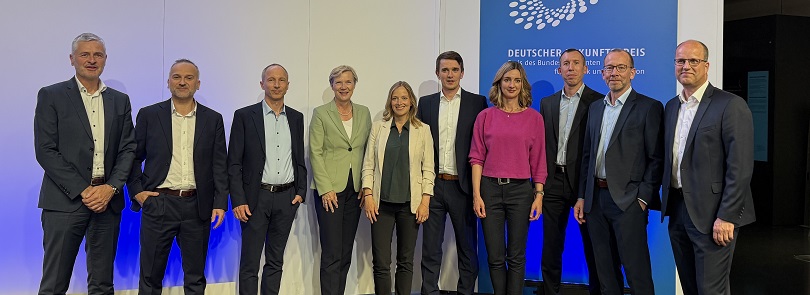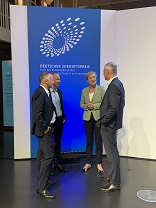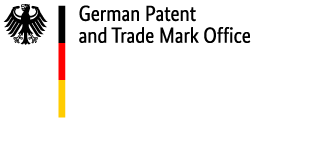Content
Deutscher Zukunftspreis 2025: Innovative eye surgery, attractive plastic alternative, climate-friendly truck drive system

DPMA President Schewior (4th from left) with all nominees
Sharp vision for millions of people: gentle and highly innovative procedure for eye surgery among the three finalists for the Deutscher Zukunftspreis at the suggestion of the German Patent and Trade Mark Office – DPMA President: procedure takes the possibilities of eye surgery to a new level – two other teams nominated

DPMA President Schewior with the team proposed by the DPMA
Press release of 17 September 2025
Munich. It is gentle, safe – and helps millions of people see better: on the recommendation of the German Patent and Trade Mark Office (DPMA), a highly innovative eye surgery procedure has been nominated for the Deutscher Zukunftspreis awarded by the Federal President. ‘Good vision is extremely important for our quality of life. That is another reason why I am delighted that the innovation we proposed from Carl Zeiss Meditec AG has been nominated for the Federal President’s Award for Innovation and Technology and will thus receive this outstanding recognition,’ says DPMA President Eva Schewior. ‘With its development, the team has taken the possibilities in eye surgery to a new level. It is impressive that such precise and gentle procedures are possible even on an organ as complex and sensitive as the eye.’
Dr Mark Bischoff, Dirk Mühlhoff and Dr Gregor Stobrawa from Carl Zeiss Meditec AG (Jena) developed the procedure known as SMILE. It is an alternative to the previously most commonly used LASIK procedure and is becoming increasingly widespread. Both procedures can correct vision problems. In LASIK, a pulsed laser is first used to make a number of incisions in the cornea so that a flap, i.e. a strip of cornea, can then be laid to one side and a lenticule removed. This optimises vision, but side effects such as dry eyes can sometimes occur. In addition, the flap never grows back properly and can be mechanically displaced, for example when rubbing the eyes.
With the SMILE procedure, however, the surgeon does not need to cut a flap from the cornea. Instead, the lenticule is separated inside the eye using ultra-short laser pulses. Only a tiny incision is required to remove it. This changes the shape of the front of the cornea, thereby correcting the refractive power. As a result, ‘dry eyes’ occur less frequently and impairments due to mechanical effects are virtually eliminated.
The procedure is made possible by a high-performance lens developed by ZEISS and extremely powerful laser beam control.According to the team, the innovation is protected by patents from more than 70 patent families.
The following teams were also nominated for the Future Prize:
Dr Anne Lamp, Sina Spingler and Niklas Rambow from traceless materials GmbH (Hamburg) have developed a natural and environmentally friendly alternative to plastic. Plastic has become an integral part of our everyday lives, but it is known to pose a major problem: when disposed of as waste, natural microorganisms cannot break it down. It therefore remains in the environment for hundreds to thousands of years, at least in the form of microplastics, polluting soil and oceans and posing a threat to human and animal health.
This is where the team comes in. It has developed a biomaterial that can replace plastics without causing lasting damage to the environment. Instead of relying on chemically modified bioplastics, the team uses only molecules and polymers that occur naturally in plants, which are not chemically modified and are therefore biodegradable. Granules produced from this material can be used in existing machinery in the plastics industry, and actually consume less energy in the process. Although it is not suitable for all products, such as those that need to be permanently water- or heat-resistant, it opens up new, sustainable possibilities for short-lived everyday items or packaging in online retail.
Christoffer Uhr, Kai Weeber and Pierre Andrieu from Robert Bosch GmbH (Stuttgart) have developed a fuel cell technology that uses hydrogen to power trucks efficiently and without emissions. While batteries are a good solution for passenger cars, they are often not suitable for heavy goods vehicles. To deliver the required power, they would have to be very large and would then usually be too heavy and take too long to charge. Fuel cells, on the other hand, enable a long range, fast refuelling and a significantly higher payload, as trucks powered by hydrogen remain much lighter than those with large batteries.
Unlike battery-powered vehicles, which use electricity stored in batteries, a fuel cell generates electrical energy directly through the chemical reaction of hydrogen and oxygen to form water. The team has developed the entire drive train and a complex control system to match. This makes the drive system not only powerful, but also functional and economical under extreme conditions. Their system is already in series production and is used in several thousand trucks worldwide. However, for the solution to be truly environmentally friendly, the use of green hydrogen, i.e. hydrogen produced from renewable energies, is crucial.
‘All three teams are already winners,’ says the DPMA President. ‘They turn technical research into attractive and marketable products, offering solutions to pressing social challenges and demonstrating how powerful and versatile Germany is as a location for innovation.’
The nominated teams presented their innovations today (17 September) at the Deutsches Museum in Munich.
The jury will decide on 19 November who will win the Deutscher Zukunftspreis – the Federal President's Award for Technology and Innovation. The award ceremony with the Federal President in Berlin will also be broadcast live on ![]() zdf.de or
zdf.de or ![]() deutscher-zukunftspreis.de. ZDF will broadcast the recording on its regular TV programme.
deutscher-zukunftspreis.de. ZDF will broadcast the recording on its regular TV programme.
The German Patent and Trade Mark Office
Inventiveness and creativity need effective protection. The DPMA is the German centre of expertise for all intellectual property rights – for patents, utility models, trade marks and designs. As the largest national patent office in Europe and the sixth largest national patent office in the world, it represents the future of Germany as a country of inventors in a globalised economy. Its approximately 2,800 employees at three locations – Munich, Jena and Berlin – provide services to inventors and companies. They implement the Federal Government's innovation strategies and further develop national, European and international protection systems.
Pictures: DPMA
Last updated: 17 September 2025

Not only protecting innovations
Social Media